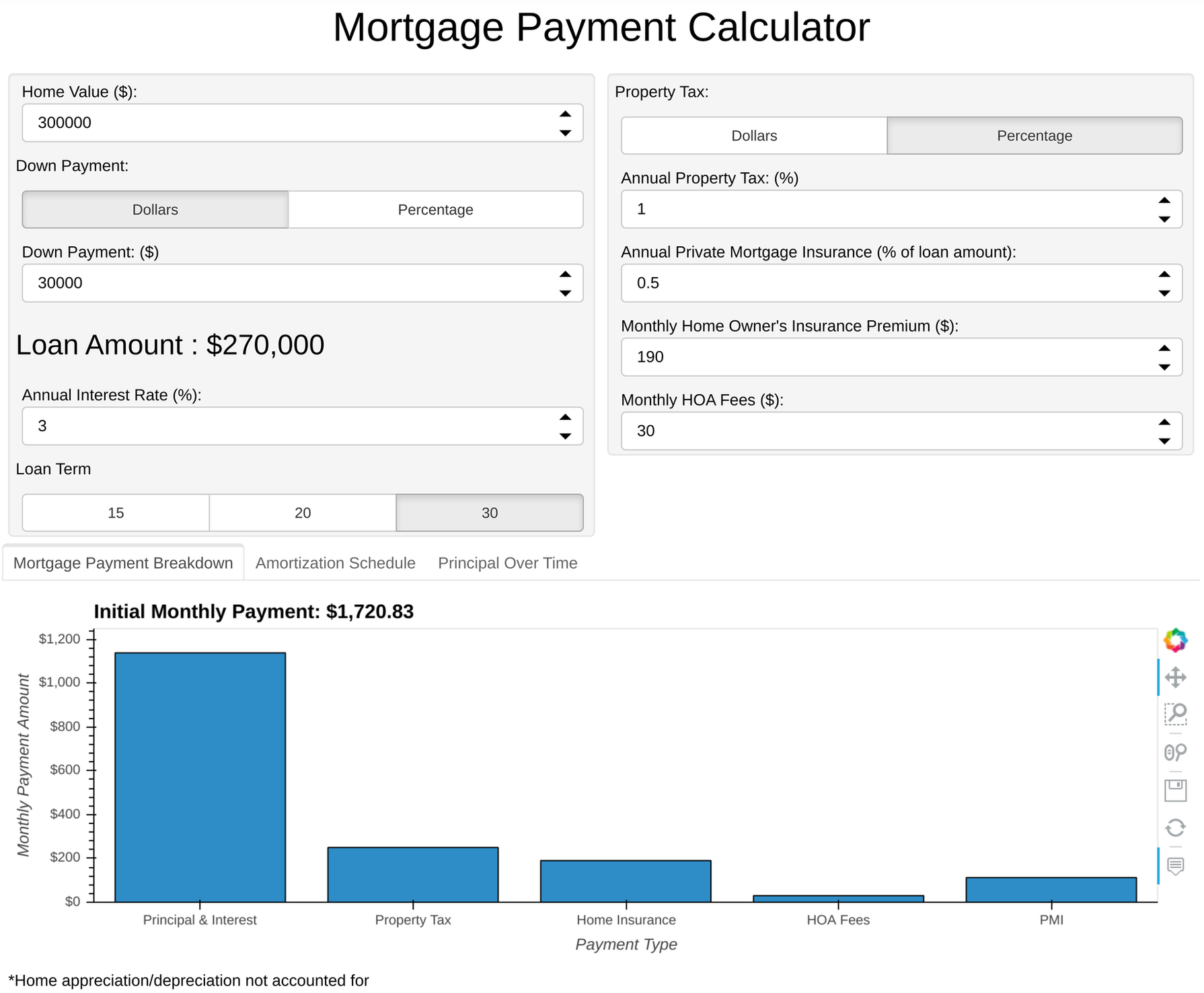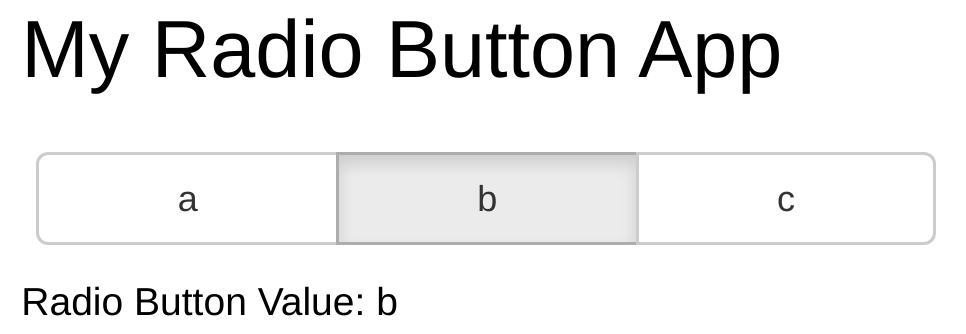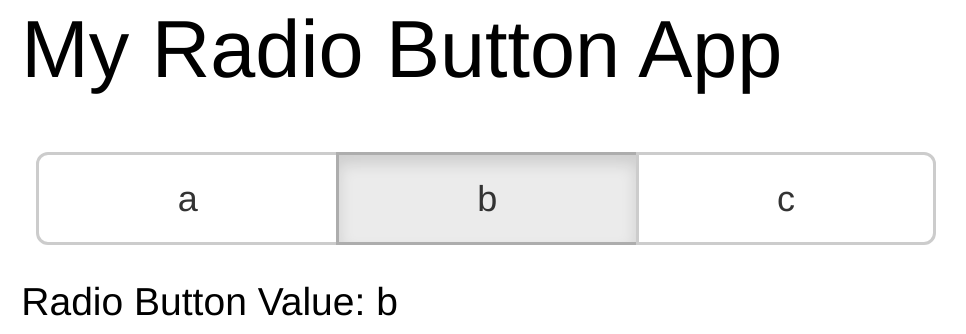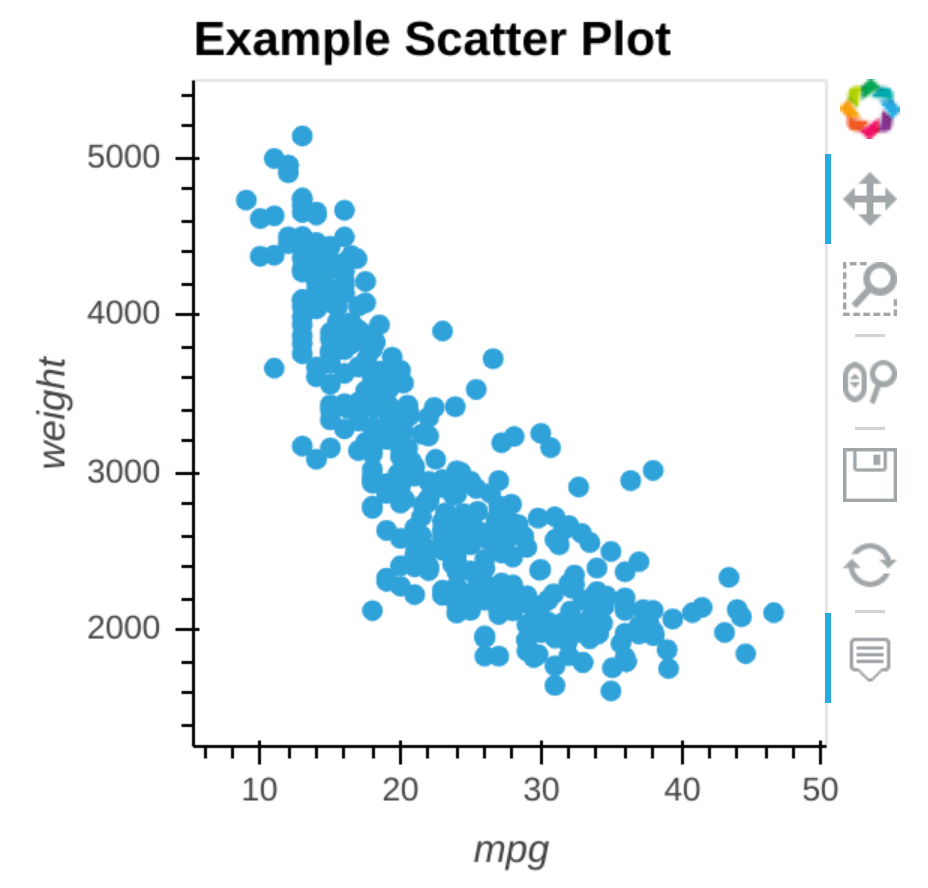import panel as pn
import holoviews as hv
from mortgage_calculator.layout import layout as mortgage_app
pn.extension()
Try out the app below. It’s a mortgage calculator app allowing you to see your mortgage payment, amortization schedule, and principal paid over time.
jupyter labextension install @pyviz/jupyterlab_pyviz in the terminal to install the needed Labs extension. This is not needed if running in a Jupyter notebook outside of JupyterLab.
mortgage_app

Prototyping in Jupyter
jupyter labextension install @pyviz/jupyterlab_pyviz in the terminal to install the needed labextension if you didn’t above. This is not needed if running in a Jupyter notebook outside of JupyterLab.import panel as pn and pn.extension() at the top of the notebook.After doing so, you should be all set to prototype the app within JupyterLab.
Panel Basics
Row, Column, Tabs, and GridSpec.Take a look at more examples of panes, widgets, and panels (layouts) at the Panel Reference Gallery. You can also learn about what parameters each widget supports by clicking on a particular widget from there.
2. Building the App Backbone
First, let’s make a widget by running the code below.
radio_button = pn.widgets.RadioButtonGroup(
options=["a", "b", "c"], value="a", name="radio_buttons"
)
radio_button

When choosing a widget for your app, try to choose a widget made for the applicable datatype (string, float, int, set, etc.). This will greatly reduce the amount of custom input validation you’ll need to do. Also notice that you can manipulate widgets in the UI or in code.
radio_button.value = "b"

Making a Sample Layout
We combine a widget and some markdown panes with a Column panel in the next cell.
# Markdown Pane
radio_button_display = pn.pane.Markdown(f"Radio Button Value: {radio_button.value}")
# Combine Panes and Widget in the Column panel
layout = pn.Column("## My Radio Button App", radio_button, radio_button_display)
layout

You’ll notice the display doesn’t update when a different radio button is pressed. To update we need to make a function to call when a specific widget’s value is modified.
Note: Panel has four different API’s. This learning aid uses the callback API, which is the lowest level of the four and gives the most control.
# Defines the function to call when Radio Box is updated.
def update(event):
if event.obj is radio_button:
radio_button_display.object = f"Radio Button Value: {radio_button.value}"
# Run the update function when the "value" parameter of radio_button widget changes.
radio_button.param.watch(update, "value")
# Now the display updates when the button is pressed.
layout

Be careful about running the above cell multiple times. Doing so will attach multiple function callbacks to the radio button, and the app may not behave as expected. Restarting the kernel and rerunning the cells will fix this.
You may be wondering why the if statement in the update function is needed. In this simple example, it’s not. However, as we add more widgets I’ve found it’s nice to have a single update function for all widgets in order to more precisely specify the order in which pane updates need to happen as well as share intermediate results computed during the update function.
3. Holoviews Plots
The app above could serve as the start of many, many apps, but how exactly do we update plots based on widgets instead of just some text? It’s pretty simple, we just replace the Markdown pane with a HoloViews pane. The Panel HoloViews pane is a wrapper around Holoviews plots. Other plotting libraries (matplotlib, plotly, etc.) are supported as well, but I’ll be demonstrating with Holoviews plots.
# Define some sample data and import holoviews
from bokeh.sampledata.autompg import autompg
import holoviews as hv
# show data sample
autompg.sample(2)

A complete tutorial of plotting in Holoviews is beyond the scope of this learning aid. For this example, just know that hv.Scatter(dataframe, kdims="x_column", vdims="y_column") will produce a scatter plot. The HoloViews documentation can be consulted for additional specifics.
hv.Scatter(data=autompg, kdims="mpg", vdims="weight").opts(
tools=["hover"], size=6, title="Example Scatter Plot"
)

Let’s make an app which toggles the axes of the plot. First we’ll make the radio buttons to toggle the axis.
radio_opts = [col for col in autompg.columns if col not in {"origin", "name"}]
auto_mpg_radio_x = pn.widgets.RadioButtonGroup(options=radio_opts, value="mpg")
auto_mpg_radio_y = pn.widgets.RadioButtonGroup(options=radio_opts, value="mpg")
auto_mpg_radio_x

Now let’s set up the layout of the plot.
auto_plot = pn.pane.HoloViews(
object=None, sizing_mode="stretch_width"
) # empty plot initially
layout = pn.Column(
"## Auto MPG App",
pn.Row("#### x-axis:", auto_mpg_radio_x),
pn.Row("#### y-axis:", auto_mpg_radio_y),
auto_plot,
sizing_mode="stretch_width",
)
Next, let’s configure the plot to update when the widget values are changed.
def autompg_plot(x_axis, y_axis):
return hv.Scatter(data=autompg, kdims=x_axis, vdims=y_axis).opts(
tools=["hover"], size=6, max_width=750
)
def auto_mpg_update(event):
if event.obj is auto_mpg_radio_x:
auto_plot.object = autompg_plot(auto_mpg_radio_x.value, auto_mpg_radio_y.value)
if event.obj is auto_mpg_radio_y:
auto_plot.object = autompg_plot(auto_mpg_radio_x.value, auto_mpg_radio_y.value)
# Run the update function when the "value" parameter of radio_button widget changes.
for widget in [auto_mpg_radio_x, auto_mpg_radio_y]:
widget.param.watch(auto_mpg_update, "value")
# trigger initial plot update
auto_mpg_radio_y.value = "cyl"
layout

Be careful about running the above cell multiple times. Doing so will attach multiple function callbacks to the radio button, and the app may not behave as expected. Restarting the kernel and rerunning the cells will fix this.
4. A Note on App Deployment
After you build an app, you’ll want to deploy the app so others can view it. Deployment is beyond the scope of this learning aid, but the Panel server deployment documentation covers a variety of deployment scenarios. MyBinder is useful for apps that are for demonstration purposes only. If you want to see how your app would look deployed by itself, then you can run app.show() in the notebook, and a new browser tab will open up with the app served on it. Run the cell below to see it in action.
layout.show() # You won't be able to view this from binder, but will be able to if running locally.
Now that you have a simple app to start from, keep going and build your own!
If you liked this article, check out this Panel article on Working Across Panel and ipywidgets Ecosystems!